|
Family: Psittacidae (parrots, lovebirds)
Life
> Eukaryotes >
Opisthokonta
> Metazoa (animals) >
Bilateria >
Deuterostomia > Chordata >
Craniata > Vertebrata (vertebrates) > Gnathostomata (jawed
vertebrates) > Teleostomi (teleost fish) > Osteichthyes (bony fish) > Class:
Sarcopterygii (lobe-finned
fish) > Stegocephalia (terrestrial
vertebrates) > Tetrapoda
(four-legged vertebrates) > Reptiliomorpha > Amniota >
Reptilia (reptiles) >
Romeriida > Diapsida > Archosauromorpha > Archosauria >
Dinosauria
(dinosaurs) > Saurischia > Theropoda (bipedal predatory dinosaurs) >
Coelurosauria > Maniraptora > Aves
(birds) > Order: Psittaciformes
Species indigenous to southern Africa
|
Agapornis
lilianae (Lilian's lovebird) The
Lilian's lovebird mainly occurs in a small area from Zimbabwe to Zambia and
Mozambique, preferring mature Mopane (Colosphermum mopane) woodland
and riparian forest. It mainly eats grass seeds, but it may also feed on
agricultural crops, flowers and fruit. It is highly sociable and gregarious,
foraging on the ground in flocks of up to 600 birds! Its breeding habits are
little known in the wild - it is thought to be a monogamous, loosely
colonial nester. It mainly nests in natural tree cavities, where it lays
about 4-5 eggs, which are incubated solely by the female for about 22 days.
The chicks are cared for by both parents, staying in the nest for about 44
days. |
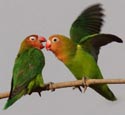 |
|
Agapornis
nigrigenis (Black-cheeked lovebird) The
Black-cheeked lovebird is a rare vagrant in southern Africa, as it has only
been reliably recorded once, at Victoria Falls, Zimbabwe. Its distribution
is highly localised, with its population restricted to south-western Zambia
(because of its small, localized population, it is now considered
Vulnerable). It mainly occupies Mopane woodland, but also Acacia
woodland and agricultural areas - it is never far from water. It mainly eats
grass seeds, especially Echinochloa colona (Jungle rice), with the
rest of its diet largely made up of leaves and flowers. |
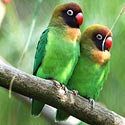 |
|
Agapornis
roseicollis (Rosy-faced lovebird) The Rosy-faced lovebird is found exclusively in Namibia, but
it is a popular cage bird worldwide, so escapees can be found outside its wild
range. It lives in various types of woodland, often with rivers
nearby. It eats mainly seeds, the rest being largely made of fruits and, rarely,
flowers. It lives in noisy gregarious colonies, which use many different types of
nesting sites. It lays 4-6 eggs, which are incubated by the female only, for 23
days. The female broods and feeds the chicks, while the male does all the
foraging. |
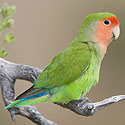 |
|
Poicephalus
cryptoxanthus (Brown-headed parrot) The
Brown-headed parrot is found only in the top half of southern
Africa, where it is common in Zimbabwe and northern Botswana. It lives in
various types of woodland, usually near water. It prefers to eat seeds and nuts,
as well as fruit, flowers and, rarely, insects. It nests in tree cavities,
sometimes made by woodpeckers and barbets, where it lays 2-4 eggs, which are
incubated by the female for 29-31 days. The chicks are fed by both their
parents, who regurgitate the food upside down, to help facilitate regurgitation.
The brood stay in the nest for 60-84 days (In captivity), and, once they have
left the nest, may still be dependent on their parents into the next egg-laying
season. |
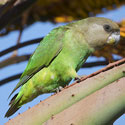 |
|
Poicephalus
fuscicollis (Grey-headed parrot) The
Grey-headed parrot is uncommon yet widespread, occupying an area from
Tanzania to Zimbabwe. It occurs in a variety of woodland habitats, including
Miombo. Mopane and riparian woodland, feeding almost exclusively on fruit.
It nests in natural tree cavities, usually in the trunk or in the underside
of a branch. Here it lays 2-4 eggs, which are incubated solely by the female
for 28-30 days. The male contributes by providing food for the female and
chicks. They learn to fly when they are about 68-83 days old, only becoming
fully independent 4-5 months later. |
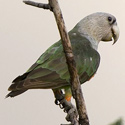 |
|
Poicephalus
meyeri (Meyer's parrot) The Meyer's
parrot is found only in the northern half of southern
Africa, where it is common in Zimbabwe and northern Botswana. It lives in
various types of woodland, usually near water. It prefers to eat seeds and nuts,
as well as fruit, flowers and, rarely, insects. It nests in tree cavities,
sometimes made by woodpeckers and barbets, where it lays 2-4 eggs, which are
incubated by the female for 29-31 days. The chicks are fed by both their
parents, who regurgitate the food upside down, to help facilitate regurgitation.
The brood stay in the nest for 60-84 days (recorded in captivity), and, once they have
left the nest, may still be dependent on their parents into the next egg-laying
season. |
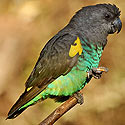 |
|
Poicephalus
robustus (Cape parrot) The Cape parrot
is endemic, endangered and highly localised, being found in small patches of
Afromontane forest in the Eastern Cape and KwaZulu-Natal. It feeds
exclusively on fruit, mainly foraging in the early morning and late
afternoon. It nests in pre-existing tree holes, especially in
Podocarpus (Yellowwood). The felling of yellowwood trees is the main
reason for its Endangered status, as it results in difficulty in location of
nesting sites, leading to a poor reproductive rate. The female lays 2-5
eggs, which are incubated by by the female only, for 28-30 days. The chicks
stay in the nest for 55-79 days, after which they may remain with their
parents for about one year. For information, visit the
Cape Parrot Working Group. |
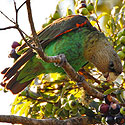 |
|
Poicephalus
rueppellii (Rüppell's parrot) The Rüppell's
parrot is near endemic to Namibia, occurring in habitats ranging from
riparian woodland to Acacia as well as palm tree stands. Its diet
varies according to time of year, eating a range of plants and occasionally
insects. It nest's in tree cavities (especially cluster leafs and Acacia),
either natural or excavated by woodpeckers. Here it lays 3-5 eggs, which are
incubated for about 24-30 days, mainly by the female (recorded in
captivity). In captivity, the chicks stay in the nest for about 50-51 days.
Its population numbers are threatened by the cage bird trade - an estimated
600-1000 birds are exported annually to South Africa and Europe, about
60-70% of which die while in transit. |
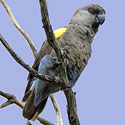 |
|
Psittacula
krameri (Rose-ringed parakeet) The
Rose-ringed parakeet is not indigenous to southern Africa, but is rather and
introduced species, with feral populations centred around Durban and
Johannesburg. It occurs in a wide variety of habitats, ranging from savanna
to riparian woodland, however it is most common in parks, gardens, farmland
and other man-made habitats. It is highly sociable and gregarious, feeding
mainly on fruit and seeds. It nests in tree cavities, either natural or made
by barbets, but also uses rock crevices, buildings and nest boxes. Here it
usually lays 3-4 eggs which are incubated mainly by the female, for about 28
days. The chicks stay in the nest for about 6-7 weeks, becoming fully
independent a few months later. |
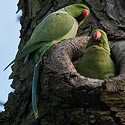 |
|
